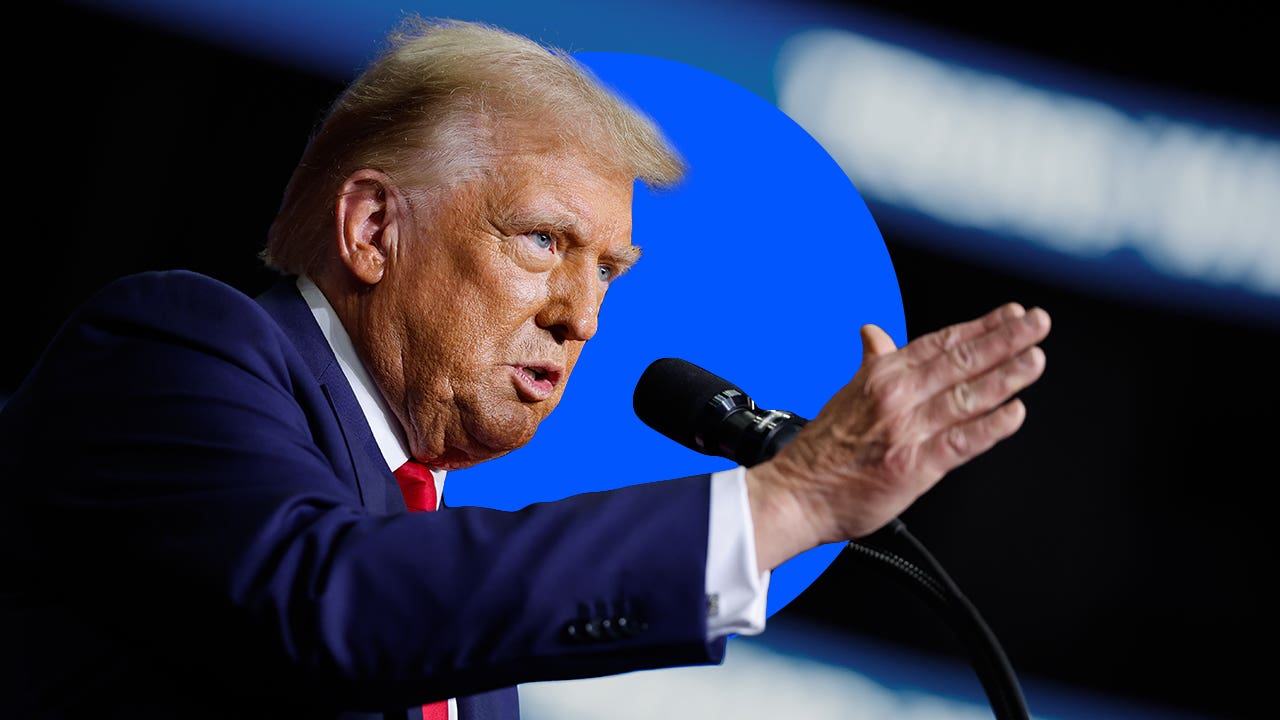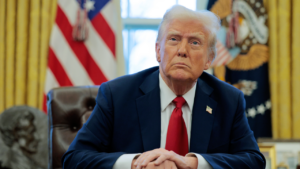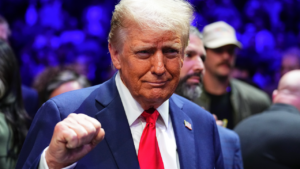The ‘Trump Trade’: What it is and how it impacts the markets

Markets rode a wave of euphoria following Donald Trump’s Nov. 5 victory in the 2024 presidential election. The Dow Jones Industrial Average climbed 3.6 percent while the broader S&P 500 rose 2.5 percent the day after the election, further boosting an already bullish year for stocks.
Lingering concerns about inflation and the broader U.S. economy were top of mind for voters heading into November. Now, investors are leaning into “Trump Trade 2.0,” fueled by anticipated pro-business policies, tax cuts and deregulation under a unified Republican government.
45 percent of Americans think Trump will be good for the economy
Trump’s win took place against a backdrop of economic anxiety. Bankrate’s October 2024 Politics and Economy Survey revealed that 41 percent of Americans named inflation as their top economic concern heading into November. The same survey found a majority (55 percent) of Americans believed the economy is on the “wrong track.”
When asked which presidential candidate would be better for the economy, 45 percent of Americans picked Trump compared to 40 percent who picked Vice President Kamala Harris. Americans also rated Trump higher than Harris on addressing personal financial situations and inflation.
However, the economy was already sizzling prior to the election, as Bankrate Senior Economic Analyst Marc Hamrick points out.
“We saw new highs for the stock market’s major averages, falling inflation, the Federal Reserve shifting into easing mode and a job market close to the level associated with full employment,” he says.
But how people feel about their finances doesn’t always mesh with broader economic data.
“Perceptions about where we stand are far apart,” says Hamrick. “Some of that has little to do with the broader economy.”
The Trump Trade, explained
The Trump Trade describes the shift in market sentiment in response to President-elect Trump’s proposed economic policies.
With a GOP majority in Congress, Trump’s incoming administration has pledged to roll out an agenda focused on tax cuts, deregulation and other business-friendly measures.
Here’s a closer look at how stocks and other investments have performed in the wake of Trump’s win.
Stocks
Stocks across multiple sectors surged post-election. The Dow Jones Industrial Average and S&P 500 logged their strongest months of 2024 in November. Meanwhile, the small-cap-heavy Russell 2000 took the lead, surging 10.8 percent for the month as investors anticipated small companies benefiting from Trump’s proposed tax cuts.
Shares in energy and financial companies also rallied, as these sectors stand to benefit the most from deregulation.
But some of the biggest beneficiaries of the Trump Trade are companies tied to Trump, his family or his close associates.
Shares of Tesla (TSLA), the electric vehicle maker led by Trump advisor and campaign donor Elon Musk, jumped nearly 17 percent the day after the election. By Nov. 16, Tesla’s stock had soared over 40 percent since Election Day.
The stock rallied despite Trump’s dismissive stance on electric vehicles — Tesla’s flagship product — and his promises to claw back incentives and regulations that have fueled the company’s profitability.
Shares of the crypto exchange Coinbase (COIN) skyrocketed nearly 39 percent after the election, reflecting Trump’s recent embrace of cryptocurrency as a key piece of his 2024 platform.
Meanwhile, crypto companies and wealthy investors poured millions into U.S. congressional races. A super PAC named Fairshake, along with affiliated groups Protect Progress and Defend American Jobs, collectively contributed around $135 million to support pro-crypto candidates, according to The New York Times. Much of the funding originated from donations by crypto companies Coinbase and Ripple.
Another big post-election mover was Trump Media. Shares of Trump Media and Technology Group (DJT), the parent company of the Truth Social platform, shot up over 46 percent between Nov. 4, the day before the election, and Nov. 6, the day after. However, the rally was short-lived, with the stock giving up most of its gains and hovering around $30 per share for the rest of November.
The broader stock market rally is expected to continue through the end of 2024.
Stocks historically perform well in December, a phenomenon known as the Santa Claus rally — another green light for a market already excited about the potential for deregulation and corporate tax cuts.
U.S. stocks — especially in tech, financials, industrials and energy — saw significant gains during Trump’s first term. However, the stock market performed just as well under President Joe Biden as it did under Trump.
In fact, cumulative and annualized returns of the S&P 500 index, a measure of the nation’s 500 largest companies, was nearly identical under both administrations, with a 58.4 percent cumulative gain under Trump and a 58.5 percent gain under Biden.
S&P 500 Returns Under President Trump
| Year | Return |
|---|---|
| 2017 | 19.4% |
| 2018 | -6.2% |
| 2019 | 28.9% |
| 2020 | 16.3% |
S&P 500 Returns Under President Biden
| Year | Return |
|---|---|
| 2021 | 26.9% |
| 2022 | -19.4% |
| 2023 | 24.2% |
| 2024* | 26.8% |
*Year-to-date return as of Dec. 3.
Bonds
Trump’s pledges of tax cuts, deregulation and government spending may have energized stock investors, but they’ve unsettled bond markets, where concerns about inflation loom large, especially under a pro-tariff president-elect.
These worries were evident in rising government bond yields, which began climbing in August as a Trump victory became more plausible. The day after the election, the yield on the 10-year Treasury spiked to 4.43 percent, up from 4.29 percent late Tuesday — a significant move for the bond market.
While the Federal Reserve’s interest rate policy impacts most U.S. interest rates — including those on Treasury bonds — its influence diminishes over longer-term bonds. Investors in these bonds focus more on long-term growth and inflation prospects rather than current Fed policy.
Some experts predict that the Federal Reserve may keep rates elevated in 2025 to counter inflation from fiscal expansion.
By the end of November, bond yields eased, with the 10-year Treasury yield dipping to 4.2 percent.
Following Trump’s win in 2016, expectations of more government spending and a hawkish Federal Reserve also led to rising Treasury yields. The 10-year U.S. Treasury yield went from 1.82 percent in November 2016 to 3.23 percent in November 2018, then dropped.
The current bond market’s outlook remains more uncertain than the stock market’s outlook. If the Fed delays rate cuts, bond yields could rise further. This scenario could create a double-edged sword: While stocks rally on pro-growth policies, bond markets could face turbulence.
The U.S. dollar
The U.S. dollar has been on the rise, climbing roughly 1.5 percent against major currencies immediately following Trump’s victory. By Nov. 22, the broad-based dollar index had jumped 4 percent since Election Day — a big move in such a short time. From late September through mid-November 2024, the dollar gained over 7 percent.
A stronger dollar benefits American consumers by lowering the cost of imported goods and making international travel more affordable.
However, it poses headaches for U.S. exporters because their products become less competitive globally. And the biggest perks of a stronger dollar — increased purchasing power for American consumers and businesses — can be wiped out when coupled with rising interest rates and higher inflation.
The U.S. dollar appreciated against other major currencies during Trump’s first term, driven by expectations of stronger economic growth. While the dollar was healthy during most of his term — especially from January to March 2017 — it wasn’t “the strongest dollar in history,” as Trump frequently claimed and PolitiFact debunked.
Cryptocurrency
The rapid gains of the stock market pale in comparison to cryptocurrency’s moon-shot rise post-election.
Bitcoin’s price jumped 8.4 percent the day after the election, reaching a record-breaking $76,480 and shattering its previous high from March. By Monday, Bitcoin (BTC) surged to $89,600 and kept climbing, flirting with the long-awaited $100,000 milestone throughout November. In December, it finally crossed that threshold.
And it wasn’t just Bitcoin — other major cryptocurrencies joined the rally, with Ethereum (ETH) and Dogecoin (DOGE) also making notable gains post-election.
These recent moves cap off a banner year for Bitcoin, which is up a whopping 118 percent in 2024 as of Dec. 3.
Trump came out big for crypto in 2024. Once a skeptic, he rebranded as the pro-Bitcoin candidate, vowing to make the U.S. the “crypto capital of the planet” and a Bitcoin “superpower” during a high-profile speech at a Nashville cryptocurrency conference in July.
Trump’s crypto-friendly agenda includes plans for a federal Bitcoin stockpile, looser regulations and ousting SEC Chair Gary Gensler, whose tenure has been marked by aggressive oversight of the industry.
Just weeks before the election, Trump backed a new crypto venture, World Liberty Financial, a project with ties to several Trump family members.
Losers of the Trump Trade
The election left some companies and sectors in the dust following Trump’s win. Vaccine makers and healthcare companies, such as Eli Lilly (LLY) and Pfizer (PFE), saw their share prices plummet in mid-November after Trump tapped Robert F. Kennedy Jr. — a vocal vaccine and Big Pharma critic — to be the U.S. Health Secretary.
International stocks also slumped as markets digested Trump’s tariff-heavy rhetoric post-election. The president-elect has called for immediate 25 percent tariffs on all imports from Mexico and Canada once he takes office, alongside a 10 percent levy on goods from China. These proposals have raised concerns about trade tensions and potential disruptions to international supply chains, souring investor sentiment on global stocks.
Bottom line
With Republicans in control of the executive and legislative branches, the markets are pricing in a business-friendly environment and promises of a strong economy. However, investors should remain cautious. While the Trump Trade is generating buzz, economic fundamentals will ultimately determine its staying power.






